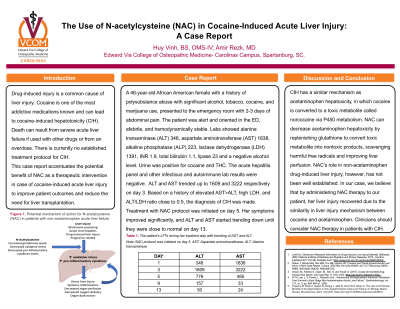Tuesday Poster Session
Category: Liver
P4722 - The Use of N-Acetylcysteine (NAC) in Cocaine-Induced Acute Liver Injury: A Case Report
Tuesday, October 29, 2024
10:30 AM - 4:00 PM ET
Location: Exhibit Hall E

Has Audio
- HV
Huy Vinh, BS
Edward Via College of Osteopathic Medicine
Charlotte, NC
Presenting Author(s)
Huy Vinh, BS1, Amir Rezk, MD2
1Edward Via College of Osteopathic Medicine, Charlotte, NC; 2Digestive Disease Associates, Rock Hills, NC
Introduction: Drug-induced liver injury is a common cause of liver injury. Cocaine is one of the most addictive medications known and can lead to cocaine-induced hepatotoxicity (CIH). Death can result from severe acute liver failure if used with other drugs or from an overdose. There is currently no established treatment protocol for CIH.
Case Description/Methods: A 46-year-old African American female with a history of polysubstance abuse with significant alcohol, tobacco, cocaine, and marijuana use, presented to the emergency room with 2-3 days of abdominal pain. The patient was alert and oriented in the ED, afebrile, and hemodynamically stable. Labs showed alanine transaminase (ALT) 346, aspartate aminotransferase (AST) 1838, alkaline phosphatase (ALP) 223, lactase dehydrogenase (LDH) 1391, INR 1.9, total bilirubin 1.1, lipase 23 and a negative alcohol level. Urine was positive for cocaine and THC. The acute hepatitis panel and other infectious and autoimmune lab results were negative. ALT and AST trended up to 1609 and 3222 respectively on day 3. Based on a history of elevated AST >ALT, high LDH, and ALT/LDH ratio close to 0.5, the diagnosis of CIH was made. Treatment with NAC protocol was initiated on day 5. Her symptoms improved significantly, and ALT and AST started trending down until they were close to normal on day 13.
Discussion: CIH has a similar mechanism as acetaminophen hepatoxicity, in which cocaine is converted to a toxic metabolite called norcocaine via P450 metabolism. NAC can decrease acetaminophen hepatoxicity by replenishing glutathione to convert toxic metabolite into nontoxic products, scavenging harmful free radicals and improving liver perfusion. NAC’s role in non-acetaminophen drug-induced liver injury, however, has not been well established. In our case, we believe that by administering NAC therapy to our patient, her liver injury recovered due to the similarity in liver injury mechanism between cocaine and acetaminophen. Clinicians should consider NAC therapy in patients with CIH.
Note: The table for this abstract can be viewed in the ePoster Gallery section of the ACG 2024 ePoster Site or in The American Journal of Gastroenterology's abstract supplement issue, both of which will be available starting October 27, 2024.
Disclosures:
Huy Vinh, BS1, Amir Rezk, MD2. P4722 - The Use of N-Acetylcysteine (NAC) in Cocaine-Induced Acute Liver Injury: A Case Report, ACG 2024 Annual Scientific Meeting Abstracts. Philadelphia, PA: American College of Gastroenterology.
1Edward Via College of Osteopathic Medicine, Charlotte, NC; 2Digestive Disease Associates, Rock Hills, NC
Introduction: Drug-induced liver injury is a common cause of liver injury. Cocaine is one of the most addictive medications known and can lead to cocaine-induced hepatotoxicity (CIH). Death can result from severe acute liver failure if used with other drugs or from an overdose. There is currently no established treatment protocol for CIH.
Case Description/Methods: A 46-year-old African American female with a history of polysubstance abuse with significant alcohol, tobacco, cocaine, and marijuana use, presented to the emergency room with 2-3 days of abdominal pain. The patient was alert and oriented in the ED, afebrile, and hemodynamically stable. Labs showed alanine transaminase (ALT) 346, aspartate aminotransferase (AST) 1838, alkaline phosphatase (ALP) 223, lactase dehydrogenase (LDH) 1391, INR 1.9, total bilirubin 1.1, lipase 23 and a negative alcohol level. Urine was positive for cocaine and THC. The acute hepatitis panel and other infectious and autoimmune lab results were negative. ALT and AST trended up to 1609 and 3222 respectively on day 3. Based on a history of elevated AST >ALT, high LDH, and ALT/LDH ratio close to 0.5, the diagnosis of CIH was made. Treatment with NAC protocol was initiated on day 5. Her symptoms improved significantly, and ALT and AST started trending down until they were close to normal on day 13.
Discussion: CIH has a similar mechanism as acetaminophen hepatoxicity, in which cocaine is converted to a toxic metabolite called norcocaine via P450 metabolism. NAC can decrease acetaminophen hepatoxicity by replenishing glutathione to convert toxic metabolite into nontoxic products, scavenging harmful free radicals and improving liver perfusion. NAC’s role in non-acetaminophen drug-induced liver injury, however, has not been well established. In our case, we believe that by administering NAC therapy to our patient, her liver injury recovered due to the similarity in liver injury mechanism between cocaine and acetaminophen. Clinicians should consider NAC therapy in patients with CIH.
Note: The table for this abstract can be viewed in the ePoster Gallery section of the ACG 2024 ePoster Site or in The American Journal of Gastroenterology's abstract supplement issue, both of which will be available starting October 27, 2024.
Disclosures:
Huy Vinh indicated no relevant financial relationships.
Amir Rezk indicated no relevant financial relationships.
Huy Vinh, BS1, Amir Rezk, MD2. P4722 - The Use of N-Acetylcysteine (NAC) in Cocaine-Induced Acute Liver Injury: A Case Report, ACG 2024 Annual Scientific Meeting Abstracts. Philadelphia, PA: American College of Gastroenterology.
